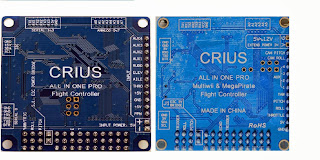Here we are talking about different adapter cables that either have to be made or buy in order to program the above accessories before they can be connected to the Crius board. There are two altogether two adapter cables for GPS and Bluetooth also converted USB-FTDI cable.
i) Bluetooth consists of 4 pins which are Vcc (5V), Gnd (ground), Txd (transmit) and Rxd (receive).
ii) GPS has the same connector as bluetooth. The pinout details are described as in (i):
iii) MinimOsd is different compared to Bluetooth and GPS. It has 6 pins with 2 extra pins which are GRN (green cable) & BLK (black cable).
- The reason for having 6 pins is that there is a reset command that gets sent to the MinimOsd when it is being programmed. If you are just using the 4 pins earlier (excluding GRN and BLK) you will face serious problem between bootloading, burning and flashing.
- There is a hardware reset switch which you can send a reset command to the MinimOsd board by pressing it. It gets really tedious if you mispressing it or wait too long to press it where it may get bootloaded. Highly advisable you get a proper cable for this MinimOsd.
- GRN pin is also known as DTR, whereas GND is known as CTS. BLK is the actual ground. (Guess this is done for orientation purpose)
- You gonna need different programmer for MinimOsd compared to bluetooth and GPS. The MinimOsd is programmed by a FTDI programmer via a FTDI programming cable. (Recommended using FTDI programmer and not the programming cable since some ppl are having issues with the cables and it is more expensive than the FTDI programmer).
- When I start programming all of these accessories, I did not use FTDI but I decided to build or convert a USB RS232 TTL converter which is normally used to programme Bluetooth and GPS. So, I modified it so that I can also use it to programme the MinimOsd.
- USB RS232 TTL has the same set-up as FTDI programmer with GND, CTS, 5V, TX, RX, and DTR pins. These allow me to convert USB -RS232 TTL programmer into a FTDI programmer which enables me to programme both Bluetooth and GPS with USB-RS232 TTL and the MinimOsd. Then we have to label the wire by printing the same text exactly as in the FTDI programmer (GRN, TX, RX, VCC, GND, BLK) to prevent mistakes.
- Please take note that I actually swap the pin TX and RX between MinimOsd and USB-RS232 TTL. Here, I just change the connection of the wires connecting to TX and RX of USB-RS232 TTL.
iv) In programming GPS and Bluetooth, we are using the same type of cables here which is the USB-RS232 TTL connected a header. But this time, we have to do a bit modification on the header since both GPS and Bluetooth only needs 4 pins connection. (GRN=DTR and GND=CTS not required).
Attached picture below shows the detailed connection of wires for each of the accessories above.
As usual, a song for a day to cheer up and have greater faith in God :)
~ Cornerstone ~
That's all folks :)





